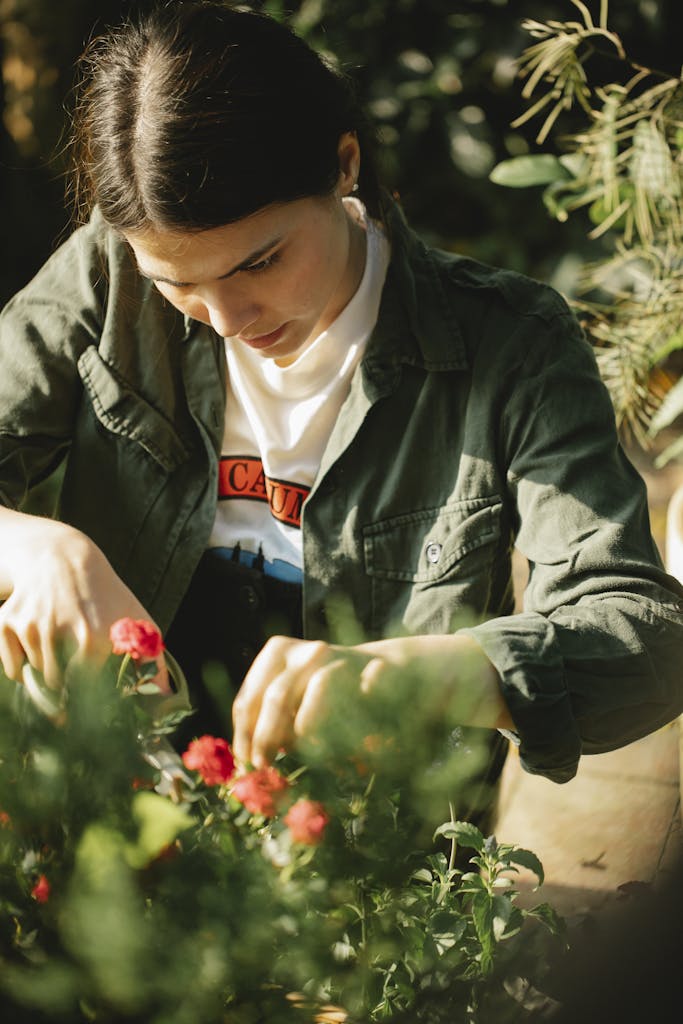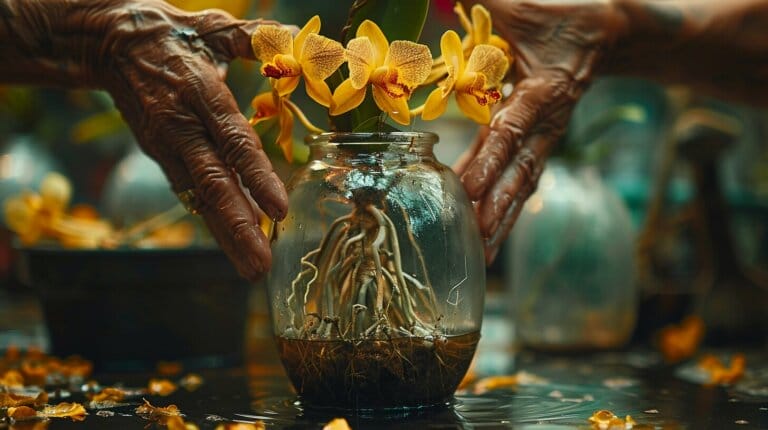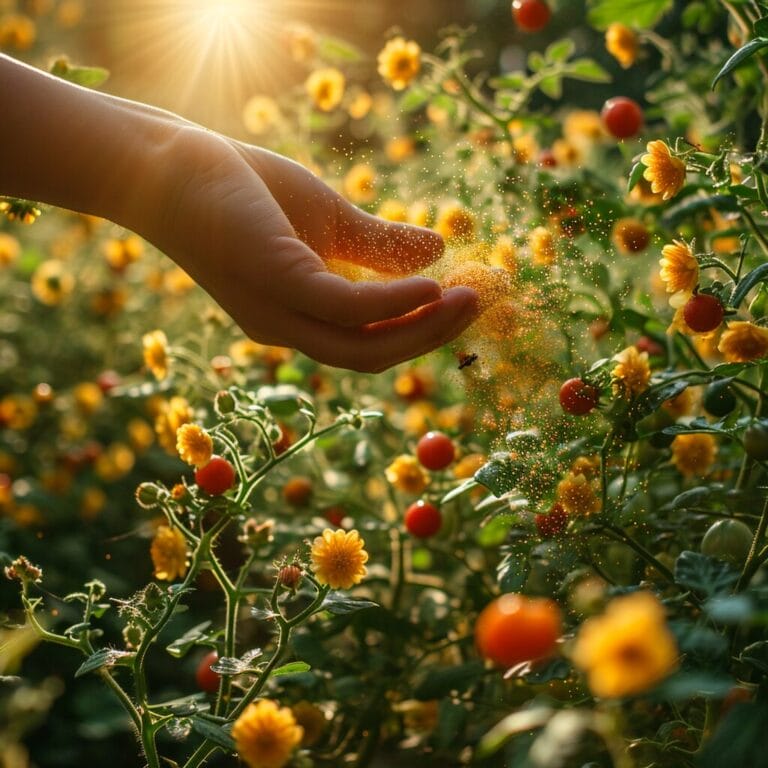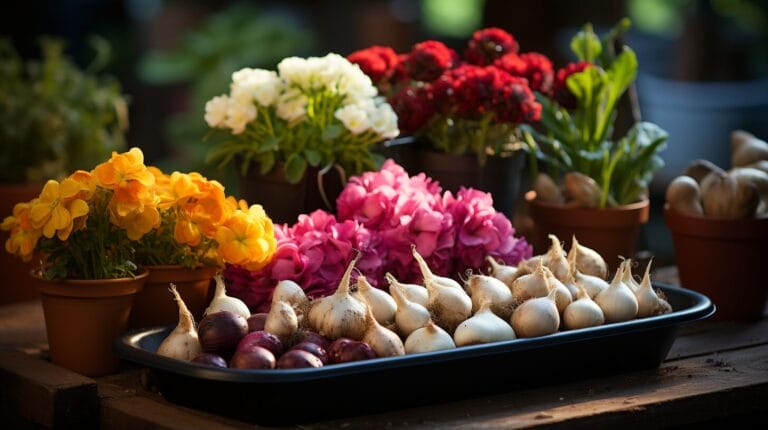Tomato Male and Female Flower: Guide to Tomato Flower Pollination
I’ve consistently found myself captivated by the wonders of nature, especially the intriguing tomato plants. They’re admired for their capacity to self-fertilize, housing both male and female flowers.
In this article, I’ll break down the structure of these unique flowers, explain the pollination process, and even show you how to hand pollinate to maximize your yield. It’s simpler than you might think!
Key Takeaways
- Tomato flowers have male and female parts, with the male part called the anther and the female part called the stigma.
- Female tomato flowers are typically larger than male flowers and exhibit a greenish hue. In contrast, male flowers have bright yellow pollen-producing stamens at the center.
- Pollination in tomato plants occurs naturally with the help of wind and insects, with wind carrying pollen to female flowers and insects inadvertently having pollen on their bodies.
- Self-pollination in tomato plants occurs when pollen from the stamen is transferred onto the stigma within the same flower, ensuring a higher percentage of fruit set and maintaining desired traits.
Understanding the Structure of Tomato Flowers
Let’s kick off by getting familiar with the anatomy of tomato flowers.
Next, we’ll determine how to differentiate between Staminate and Pistillate structures.
Lastly, we’ll touch on the typical color and size variations between Staminate and Pistillate tomato flowers.
An Introduction to the Anatomy of Tomato Flowers
I often find it fascinating to delve into the complex anatomy of tomato blossoms. Its structure is intricate, with both Staminate and Pistillate parts.
- The Staminate produces pollen, which is vital for the plant’s reproduction.
- The Pistillate is where fertilization occurs after the pollen grains land on it. If you’ve ever observed a tomato blossom, you’d see these parts quite clearly.
Understanding these elements not only quenches our curiosity but also can help in improving cultivation methods. So, whether you’re a gardener, a botany student, or simply someone fascinated by nature’s complexities, getting to know its anatomy can be enlightening.
Each is unique in its own way, and some may be either male or female, while others are both. This diversity is typical among different tomato varieties, just as in many other garden plants.
Differentiating Between Male and Female Flower structures
In this section, we’ll delve deeper into the structures. I’ll guide you on differentiating between the male and Pistillate parts.
Tomato plants are fascinating, and learning about their flowers can deepen your appreciation for these plants and their different varieties.
- Male and female are both found on the same plant. A tomato flower is both Staminate and Pistillate, containing the Staminate parts known as the stamen, which produce pollen, and the Pistillate parts, where fertilization and fruit formation occur.
- The Staminate parts consist of a slender filament and an anther at the tip, and it’s the anther that holds the pollen. To get pollinated, tomato blooms that contain the female pistil need the pollen to be transferred from the male stamen to the female pistil. This can be done by the wind or with the help of insects like bees.
- The Pistil is where fertilization and fruit formation occur.
Remember, for tomatoes to produce a single fruit, the ovary of a female needs to be pollinated. This is important because, without fertilization, the fruit will remain unviable. The assistance of insects and wind helps in this process, as they can move the pollen from the male to the Pistillate parts.
So, next time you observe tomatoes in your garden, you’ll know how to distinguish between the Staminate and Pistillate organs and understand the crucial role they play in the production of one tomato. If you choose to assist in fertilization, use the same brush or a small paintbrush to ensure that the pollen may be transferred effectively onto the end of the female pistil, increasing the chances of successful fruit formation.
Typical Color and Size Variations Between Staminate and Pistillate Tomato Flowers
There’s a wide range of color and size variations between Staminate and Pistillate, and it’s fascinating to observe these differences.
The size difference is often noticeable. Typically, the Pistillate is more significant because it contains the ovule-producing reproductive organ.
Both reproductive parts are also different in color. Males usually have bright yellow pollen-producing stamens at the center of the flower. At the same time, the females exhibit a greenish hue. It’s important to note that these color variations can change based on the health and maturity of the plant.
Understanding these variations aids in identifying and nurturing the Staminate and Pistillate for a bountiful harvest.
To do this, you can use a small paint brush to collect the pollen from the males’ stamens and then pollen and make sure to apply it to the pistil. This process, akin to using a toothbrush and collecting the pollen in a small container, is essential for successful fertilization.
The pollen in a small container is then carefully transferred to the female. Transferring pollen from the male to the female is crucial for fertilization, and it’s the means that the pollen travels to the inside of the flower where fertilization occurs. The wings of pollinators like bees and butterflies also play a significant role in this process.
Pollination Process in Tomato Plants
Now, let’s move on to understanding the pollination process in tomato plants.
We’ll discuss how this fascinating process occurs naturally and the essential roles of Staminate and Pistillate flowers.
Then, we’ll see how these pollinated blooms transform into the tomatoes we enjoy in our salads and sauces.
How Pollination Occurs Naturally in Tomato Plants
Often, I’ve observed that pollination in tomato plants happens naturally with the help of wind and insects. These natural plant fertilizers assist in transferring pollen from the male to the female, facilitating the fertilization process.
Let’s delve a bit further:
- The wind carries the pollen to the female. It’s an unpredictable yet magical process, reminding us of nature’s power.
- Insects, particularly bees, play a crucial role. They’re drawn to the vibrant colors and the scent of the flowers.
- As they move from flower to flower, they inadvertently carry pollen on their bodies.
- This pollen then brushes off onto the female, completing the fertilization process.
In essence, the natural fertilization of tomato plants is a testament to the intricate and harmonious dance of nature.
Many plants rely on these biological processes to begin to get the plants to flower. The insects’ wings help in this intricate process of pollination.
The Role of Staminate and Pistillate Flowers in Tomato Pollination
I’ve got two key players in the tomato pollination process to introduce to you, the Staminate and Pistillate, and they each play a critical role in the production of our beloved tomatoes.
Both work together in a fascinating dance to ensure fertilization. The male produces pollen, the genetic courier needed to fertilize the female. These reproductive grains from the male must reach the female reproductive organ, the stigma, to successfully pollinate your tomatoes.
Wind and insects typically aid this process, but manual intervention can also be employed. Understanding their role in tomato fertilization helps us cultivate healthier, more productive plants. It’s a simple yet crucial component in the journey from flower to fruit.
Explaining How Flowers Turn into Tomatoes After Pollination
Let’s delve into how a flower transforms into a tomato after successful fertilization, a fascinating process. Tomato fertilization involves the transfer of reproductive grains from the male reproductive organ to the female reproductive organ. This process is crucial as it triggers the development of the tomato fruit.
The process evokes a marvel at nature’s ingenuity:
- The male organ, or stamen, produces reproductive grains which need to reach the female organ.
- This movement can happen due to wind, insects, or manual intervention.
- Once reproductive grains land on the pistil, they travel to the ovule, fertilizing it.
- This fertilized ovule then grows and develops into a tomato fruit.
Understanding this process can give anyone a deeper appreciation for every tomato they’ve ever enjoyed.
Understanding Self-Pollination in Tomato Plants
Now, let’s turn our attention to the fascinating mechanism of self-fertilization in tomato plants.
We’ll discuss the roles of Staminate and Pistillate flowers in this process, look at the conditions that favor self-fertilization, and explore how they impact the overall tomato yield.
This process is vital to understanding how tomatoes reproduce and thrive.
Role of Staminate and Pistillate Flowers in Self-Fertilization
Interestingly, I’m about to delve into the crucial role that Staminate and Pistillate flowers play in the self-fertilization process of tomato plants. It’s a fascinating phenomenon that occurs when the reproductive grains from the stamen of the tomato are transferred onto the Pistillate, allowing fertilization and fruit production.
The inherent design of the tomato Staminate and Pistillate aids this process. The stamen’s proximity to the stigma ensures direct transfer. The timing of maturity aligns perfectly with stigma receptivity. Its structure acts as a protective barrier against cross-pollination.
Their role in self-fertilization is vital not only for tomato plants’ reproduction but also for our understanding of plant biology.
Conditions Favoring Self-Fertilization in Tomatoes
I’m going to explore the conditions that favor self-fertilization in tomatoes, and it’s important to note that both environmental factors and the physical attributes of the plants play a significant role in this process.
Tomato varieties differ in their ability to self-pollinate. Some are self-pollinating, meaning both tomato Staminate and Pistillate within the same blossom and can pollinate the flowers independently.
The greenhouse environment can significantly improve the conditions for self-fertilization. Stable temperatures, controlled humidity, and the absence of solid winds facilitate reproductive grain transfer within the flower.
The physical attributes, such as the proximity of organs within the blossom, also favor self-fertilization. Therefore, understanding these conditions can optimize tomato yield.
Impact of Self-Fertilization on Tomato Yield
In this section, we’ll delve into how self-fertilization can significantly impact the yield of tomato plants. As we know, tomato blossoms contain anthers that produce reproductive grains, allowing these plants to self-pollinate. This means that the Staminate and Pistillate are found within the same bloom, which can have substantial implications for yield.
The impact of self-fertilization on tomato yield can be quite profound. Just consider:
- It guarantees fruit production, even in the absence of plant fertilizers. This can ensure a reliable yield.
- However, the lack of genetic diversity resulting from it can lead to weaker plants over time.
- Additionally, environmental conditions can influence it and, thus, yield.
Understanding these factors is vital to mastering tomato cultivation.
Techniques to Hand Pollinate Tomato Flowers
Let’s now shift our focus to the techniques of hand-pollinating tomato blossoms.
We’ll start by identifying the optimal time for it.
Then, I’ll walk you through the process step-by-step.
I’ll also share some handy tips to increase your chances of successful hand pollination.
Identifying the Right Time to Hand-Pollinate
I’ll guide you through identifying the right time for hand-pollination, a crucial step in growing tomatoes. It’s a task of patience and observation.
You see, tomato plants are both Staminate and Pistillate, capable of self-fertilization. But when you hand-pollinate, you take control, increasing the chances of fruitful yield.
First, look for:
- Open flowers.
- This is when they’re most receptive to pollen.
- A mild, dry day.
- Humidity can diminish pollen’s effectiveness.
Next, remember that you’re helping nature:
- Gentle touch.
- You don’t want to damage it.
- Love for the plant.
- You’re part of its growth journey.
Finally, relish in the process:
- Witnessing growth.
- It’s rewarding to see the fruits of your labor.
- Connection to nature.
- It’s therapeutic and humbling.
That’s how you identify the right time and way to hand-pollinate.
Step-by-step Guide to Hand Pollinate Tomato Flowers
Now, I will walk you through a step-by-step guide on manually pollinating effectively. Remember, the goal is to transfer reproductive grains from the male to the female organs within a single flower.
Check out the table below to understand the process better:
| Steps | Action | Key Points |
| 1 | Identify | Spot a flower with open petals |
| 2 | Collect | Gently shake it to collect pollen |
| 3 | Apply | Brush the pollen onto the flower’s center |
To summarize, locate a flower first that’s ready for fertilization— its petals should be open. Then, gently shake it to release the reproductive grains. Next, use a small brush to apply it directly onto its center, which houses the female organs. There, you’ve successfully hand-pollinated a tomato blossom!
Tips for Successful Hand Pollination
I’ve got five critical tips for successful hand pollination, and each one can make a significant difference in your gardening success.
- It’s crucial to understand the basics of its anatomy and the process of manual fertilization. As a gardener, your role is to mimic nature.
- Shake the reproductive grains gently from the male onto the female.
- Use a small paintbrush to collect and transfer reproductive grains if you want to be more meticulous. This method ensures that the plants produce the best results.
- Patience is vital. It is a delicate process, and rushing can damage them or fail to pollinate them effectively.
- Lastly, repeat the process. Consistency is key. The more you practice, the more successful you’ll become. Remember, plants flower when it’s time, and mastery is a journey, not a destination.
Can you Explain the Pollination Process of Ginger Flowers?
Ginger flowers undergo pollination through various types of ginger flowers. The process involves the transfer of pollen from the male to the female parts of the flower, facilitated by either wind, insects, or even humans. This essential step leads to the development of ginger fruit or rhizomes, allowing for further propagation of this versatile plant.
Maximizing Tomato Yields Through Proper Flower Management
Now, let’s focus on maximizing tomato yields through proper flower management.
Knowing the difference between males and females is crucial for a bountiful harvest.
I’ll be sharing best practices for nurturing them, along with solutions for common fertilization problems.
Importance of Understanding Staminate and Pistillate Flowers for Yield
Understanding the differences between Staminate and Pistillate can significantly impact the quantity of your yield, and I’m here to guide you through it. Grasping the importance of understanding them for yield is paramount.
- The Staminate contains reproductive grains needed for the fertilization of tomato plants.
- Without it, there’s no fruit.
- The Pistillate part is where the reproductive grains must reach for successful fertilization.
- Miss it, and you’ve lost a potential tomato.
- Both parts must be in good health to ensure maximum yield.
- A weak or damaged flower can’t do its job correctly.
Master these concepts, and you’ll maximize your tomato yields quickly.
Best Practices in Nurturing Tomato Flowers for Optimal Yield
Let’s dive into a gardener’s best practices for nurturing the plant’s flowers to maximize my tomato yield.
- Ensure the female plant is pollinated. It’s the female that sets fruit and produces fruit. For this, having a healthy plant fertilizer population is vital. Attract them with diverse plantings and avoid pesticides.
- Manage your watering. Overwatering can lead to fruit with poor taste, and under-watering can stress plants, reducing yield. Strike a balance.
- Proper pruning is also essential. It allows more sunlight to reach the flowers, enabling them to set fruit effectively.
Discover the ultimate guide to tomato planting spacing! Get your tomatoes thriving with our expert tips. Learn how far apart tomatoes should be planted for a bountiful harvest. Don’t just grow tomatoes; master the art!
Resolving Common Issues Associated with Tomato Flower Pollination
I’m tackling common pollination problems that can plague tomato blossoms. I’ll share ways to maximize your yield through proper management.
- Understanding the roles is crucial. They need to communicate effectively for successful fertilization.
- Poor pollination can result from environmental factors, improper care, or a mismatch in timing between the Staminate and Pistillate.
- Hand-pollinating can be a helpful technique when natural pollinators aren’t available or wind fertilization is insufficient.
Resolving common issues associated with pollination requires knowledge, patience, and a keen eye. But with these tools, you can ensure that every bloom has the best possible chance to contribute to your bountiful harvest. Don’t be afraid to get your hands dirty; your tomatoes will thank you!
Frequently Asked Questions
What Are the Ideal Soil Conditions for Growing Healthy Tomato Plants?
For optimal tomato growth, I’ve found that well-draining, loamy soil with a pH between 6.0 and 6.8 is ideal. It’s also crucial to enrich the soil with organic matter for nutrient availability.
How Can I Identify and Treat Common Diseases That Affect Tomato Plants?
To identify and treat common tomato plant diseases, I first examine the leaves for discoloration or spots. Then, I apply appropriate fungicides and ensure good air circulation to prevent further infections. It’s a continuous process.
What Is the Best Time of Year to Plant Tomatoes?
The optimal time to plant tomatoes is in the spring, after the last frost. They require warm soil and plenty of sunlight to thrive, so avoid planting them in the colder months.
How Often Should I Water My Tomato Plants?
Considering how often to water your tomato plants, I’d suggest daily in hot weather. However, it’s crucial to adjust this based on rainfall and soil dryness. Overwatering can cause as much harm as underwatering.
Are There Any Specific Insects or Pests That Pose a Threat to Tomato Flowers?
Several insects can harm tomato flowers. The most common are aphids, tomato hornworms, and whiteflies. They can damage them, reducing fruit production. I recommend using organic pesticides to keep them under control.
Conclusion
So, there you have it! Understanding the unique structure of tomato flowers and their self-pollination process can genuinely amplify your yield.
With a bit of practice, you can even hand-pollinate your tomato plants. Proper management is crucial, but don’t worry. It’s easier than it sounds.
After all, who doesn’t want a bountiful harvest of luscious red tomatoes?
Happy gardening!







